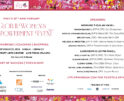
Professor Gino on How We Can Stick to a Plan
Author of Sidetracked, Francesca Gino is a professor of business administration in the Negotiation, Organizations & Markets Unit at Harvard Business School speaks to PINK on her expert topics: behavioral economics, negotiation, decision-making and leadership.
Q: How can changing the environment in which decisions are made, in both personal and professional settings, favor better decision-making?
The deep processing that the human brain uses in order to reach decisions is simply too hard wired and difficult to alter. So instead of trying to change the way individuals think in a very deep sense, behavioral economics tries to change the decision-making context in order to promote better outcomes. That means tilting the playing field in the favor of people making the right decision. In other words, behavioral economics suggests that instead of changing the way people think, we should change the environment in which they are making decisions. This has wide applicability in financial decision making, health decision making, workplace productivity, and life happiness. These are all domains where the behavioral economics framework can provide ways of improving outcomes by helping people to make better decisions in their organizations and in their lives.
Behavioral economics accepts the human brain as it is and devises strategies for changing the environment in which people are operating. We can set up the environment to either bypass the flawed ways that people make decisions or to encourage them to be more reflective. And we can bolster and engage the more effective decision-making processes that people don’t deploy when they’re distracted or off course.
All companies experience organizational problems—employees who are not productive, turnover that is too high, or products that are not succeeding in the marketplace. Thanks to what we know from behavioral sciences and psychology, we can help companies improve performance by helping their executives to make better decisions. As an example, consider the following. Often, executives fall behind on deadlines and the usual solution is to work harder. Instead, we decided to give people at one company the time to think. So for three weeks in this organization, we gave them 15 minutes at the end of each day to reflect on what they had learned throughout the day. The result: a more than 20 percent improvement in performance.
Q: How can organizations effectively test and measure strategic changes, both to workplace environment and competitive strategy? Can these measurements be used to predict behaviors of consumers, competitors and employees?
In most organizations, change happens in the following way: a problem or opportunity is identified, there is brainstorming about possible solutions, one of them gets implemented. A crucial step is missing from this process, however: a means of evaluating whether the change accomplishes what it was intended to do. That’s where experimental testing can be helpful. What this means is to introduce the change only to part of the organization, only to some of the people experiencing it, and leaving things as usual for other people. For instance, in a project my colleagues and I conducted at Wipro, the business-process-outsourcing firm, we designed a change to the onboarding process that affected only some groups of newly hired individuals. Other groups went through the on boarding process following the usual procedures used by the company. Here’s what we did in this project for those who experienced the change: We asked them to reflect on their strengths, their uniqueness, and how they could bring those out in their new jobs. Rather than feeling alienated and anxious in their new work environment, new employees who engaged in this process felt they could be themselves at work. This difference led not only to lower employee turnover but also to higher performance as measured by customer satisfaction.
Using experimental methods can effectively allow managers to precisely measure the effects of strategic changes. If the effect is positive as expected, then the change can actually be introduced. This type of thinking can be used to address questions managers may have regarding their consumers, competitors or employees.
Q: Can you offer tips on how to best assess the entire information set available when making key-decisions? When should you seek advice and how do you use advice effectively?
Executives often make poor decisions. They get distracted, they use pieces of information that maybe they shouldn’t be using, or they neglect pieces of information that they should be using. Sometimes they reach the right conclusion, but fail to implement it. Behavioral economics then gives us a way of thinking about what we can do about that. One way to reduce poor decision making is to change the way we ask questions about the data we are using. We usually ask: What information supports what I want to do? What data tells me the decision that I’m making is a good one? Instead, we should ask: Is there any information that suggests that what I’m about to do is not the right course of action?
In addition, what research tells us, is that we often focus too much on our own perspective and view, and tend to discount the advice we receive from others.
Q: What are the internal factors which shape personal decision-making processes and how can you better own strength and weaknesses in arenas like negotiation and organizational management?
[Long answer…] Many of the ideas I study and write about are motivated by my personal experience and by what surrounds me –interesting patterns of behavior that often, at first glance, make little sense. I got interested in studying decision making because I often observed situations where I or others made poor decisions and reached outcomes I/they regretted. I discuss a lot of the research on decision making I conducted over the last ten years in Sidetracked. The book focuses on situations where we set out to accomplish specific goals but ended up reaching different outcomes. Most of us care a good deal about being consistent—we care about following through on our goals and wishes. But often, without our knowledge, subtle influences—often unexpected—steer us away from what we initially planned or wanted. As a result, our decisions fail to align with our best intentions.
The research I conducted over the last ten years identifies three set of forces that derail our decisions: forces from within, forces from relationships, and forces from the outside world. Forces from within include factors that reside in people’s minds and hearts. Examples include people’s inaccurate and overly positive beliefs about their abilities and competence, the emotions caused by events unrelated to the decision at hand, and an overly narrow focus when evaluating information to inform their decisions. Forces from relationships refer to factors that characterize ties and interactions with others. People are social human beings, and relationships are beneficial to their wellbeing. Yet, bonds with others often derail their decisions due to various factors, such as the difficulty of taking the perspective of others, the similarities people share with others, and the comparisons they make between others and themselves. Finally, forces from the outside world refer to situational factors that sidetrack people’s decisions. They include irrelevant information, subtle differences in the way decisions are framed, and the structure of the context in which people operate.
As my research suggests, the forces that derail people’s decisions are predictable: they systematically intervene to sway behavior. Yet, they are also unexpected: people generally do not realize these forces are influencing their decisions.
Here are three examples of internal factors that shape personal decision making processes. Each of them highlights a difference force from within that I discuss in “Sidetracked.”
Force No. 1: Infectious Emotions
As a first example, consider Jerry Yang’s decision to reject Microsoft’s offer to buy Yahoo! in early 2008. While a student at Stanford in the early 1990s, Yang created Yahoo! with a classmate. It may be hard to remember that for a few years, Yahoo! was the most popular search engine worldwide, as well as being a leading Internet communications, commerce, and media company. But at the turn of the century, the company started to lag in the face of intense marketplace competition. Yang took over as Yahoo!’s CEO in June 2007 with the plan of guiding the company back to its early success. Meanwhile, potential buyers expressed interests in purchasing Yahoo! while it was still struggling. At a time when Yahoo’s market value was about $39 billion, Microsoft offered Yang $45 billion. But, as an inside source told the New York Post in February 2008, “The emotional part of Yang would rather do anything but sell to Microsoft.” Yang rejected what many viewed to be a highly attractive offer. The company’s stock price kept dropping, and its profit continued to shrink. The business press speculated that Yang’s emotional attachment to the company he had founded clouded his judgment, and Yahoo! was suffering as a result. When weighing the pros and cons of complex decisions, such as whether to accept Microsoft’s offer, we may feel overwhelmed. Our emotions may direct our attention and energy toward what we believe to be the most important aspects of the decision, but they may also lead us astray, as seems to have been the case for Yang. This example shows how a force from within (our emotions) can derail our decisions.
Force No. 2: Inflated Views of Our Competence and Skills
As a second example, consider the decision of the Ducati motorcycle racing team, Ducati Corse, to compete in a motorcycle racing circuit, the MotoGP, for the first time in 2003. The team had accumulated years of experience and success in other motorcycle racing circuits, but the MotoGP had different rules and required a different type of motorcycle. Consequently, team members approached their first MotoGP as a season of learning — their goal was not to win, but to gain as much knowledge about the race for future years as possible. The plan of action was clear, and the team tried to set everything up so that implementation would follow smoothly. For instance, the team’s racing bikes were fitted with sensors to capture performance data, and Ducati Corse engineers held debriefings with the riders after each race to gather feedback on the bike’s handling. Unfortunately, however, the team’s outcome bore little resemblance to its initial plan. During the 2003 MotoGP season, the team experienced unexpected success, finishing among the top three in nine races and second overall for the season. Instead of focusing on learning from all the data they were gathering, team members focused on celebrating. The unexpected success also increased the engineers’ confidence in their ability to design high-performing racing bikes. As a result, the team decided to radically redesign its bike for the MotoGP 2004 season, adding more than 60 percent new components. But the new racing bike did not perform as well as expected in the first few races of the 2004 MotoGP season. As the team members themselves recognized, their confidence sidetracked them from their goal. This example shows how a difference force from within (our overly positive views we have of our abilities, which often fuel overconfidence) can derail our decisions.
Force No. 3: Overly Narrow Focus
Funded by Lee Byung-Chull in 1938, Samsung Group is one of South Korea’s largest and most successful family-run conglomerates, as well as one of the largest, multi-billion dollar corporations in the world. The company’s storied history does not always depict success. For instance, in 1992, Chairman Lee realized a long-cherished dream of his father by announcing the group’s entry into the car sector. In a public statement raising skepticism from Samsung managers, Korean government officials, and industry commentators, the chairman announced that Samsung Motors would be among the world’s 10 largest car manufacturers within the next two decades. Despite advice for alternative investments, the chairman did not change his plans: The company had succeeded in other industries, indicating –in his eyes– that Samsung should not be afraid of entering a new business. The company invested a lot of time, money and seasoned executives to achieve success in its new venture. Yet, Chairman Lee’s plan failed to materialize. Right from the start, Samsung Auto suffered operating losses and significant interest charges on its loans. Within the span of a few years, the company had to divest its car business for a fraction of its initial investment. Chairman Lee focused too narrowly on Samsung’s past success in other contexts, and paid too little attention to the complexities of the new industry. Such narrow focus, as it turns out, is common among leaders and often sidetracks their decisions. In fact, a narrow focus of attention leads most of us to miss important information that could benefit our decisions and clarify our thinking.
In my work, and in my book “Sidetracked,” I discuss effective ways to deal with these factors. They are:
- Raise your awareness. Because our views of how capable and competent we are as individuals are often overly positive, we rely too much on our own information. By raising your awareness, you can keep your self-views in check and recognize when they may be taking you off track. Becoming more aware of the information that enters our thinking as we consider different courses of action, and of how much of it we end up using, is an important step toward making sure that our own opinions receive the appropriate weight in our decisions.
- Take your emotional temperature. Although there are many situations in which our feelings about a decision we are facing tell us something about the decision itself, there are also many situations where irrelevant emotions–those caused by an event completely unrelated to the decision at hand–take us off track. They can lead to inaccurate analyses of the information at hand, thus moving us away from our plan of producing correct analyses. By taking your emotional temperature before making a decision, you can reflect on the causes of your current feelings and determine whether they were triggered by an event unrelated to the decision at hand, and you can examine whether irrelevant emotions are clouding your judgment.
- Zoom out. We often focus too narrowly on the decision at hand and our own views about it. As a result, we fail to see the bigger picture, including other people’s roles. Zooming out involves widening our focus when considering information to include in our decision-making processes so that we don’t miss important details. By zooming out, you can include more relevant information in your decision-making process so that you can avoid decision derailment.
Being human makes all of us vulnerable to influences that, even when subtle, can dramatically impact our actions. By understanding such influences and by systematically using the principles I discuss in “Sidetracked,” I think we can successfully get back on track and make better decisions going forward.
Recommended
-
Getting What You Want At WorkDecember 20th, 2024
-
Fall 2024 EventNovember 19th, 2024
-
Pink ProgramOctober 20th, 2024
-
Influential LeadershipOctober 20th, 2024
-
REGISTER HERE FOR THE UPCOMING...September 19th, 2024















